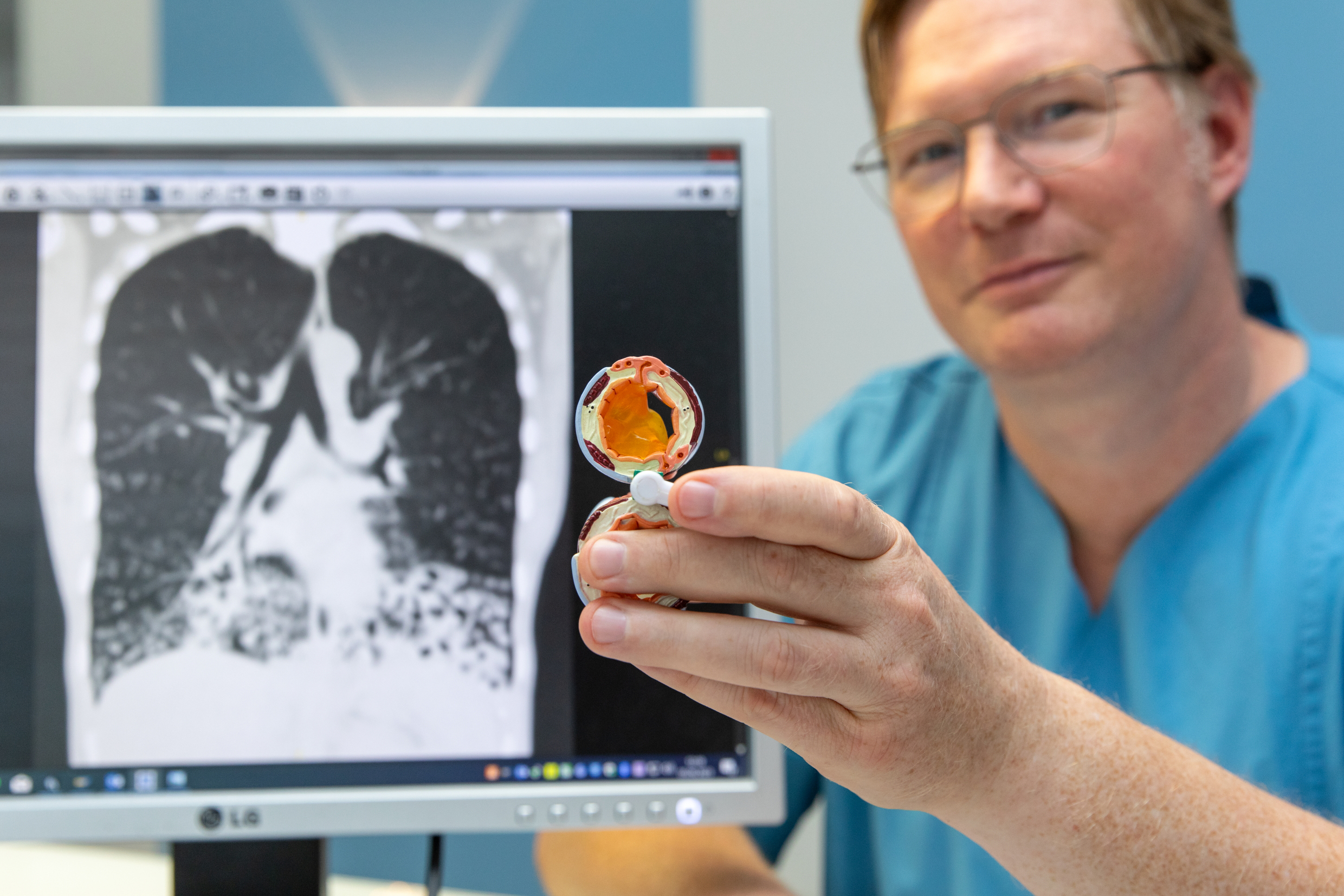The congenital multisystem disease PCD is associated with a severe respiratory and lung disease in which the cilia in the bronchial tubes are no longer able to clean the lungs, thus favouring chronic infections. An international study with the participation of the MHH now shows how the lung function of those affected could be improved.

Seeking ways for PCD patients to breathe more freely again: Dr Felix Ringshausen. Copyright: Karin Kaiser / MHH
In our lungs, the body's own cleansing system works tirelessly to remove mucus and with it cellular waste and pathogens. Fine cilia in the inner wall of the bronchial tubes transport the material towards the throat through coordinated beating movements. If the mobility of the cilia is restricted or completely lost, mucus accumulates in the upper and lower airways, making them susceptible to infection. In the congenital disease primary ciliary dyskinesia (PCD), the function of the cilia is particularly severely disturbed and self-cleaning no longer works. Affected people suffer from chronic respiratory diseases such as bronchitis, pneumonia or dilatation of the lower airways (bronchiectasis) from an early age. PCD is a rare disease and affects about one in 10,000 newborns in Germany. There is no cure.
Salt release into the blood impedes mucus removal
In addition to the cilia function, the lack of fluid in the mucus is the cause of its impaired removal in PCD. Similar to the respiratory disease cystic fibrosis, thick mucus accumulates in the airways. In cystic fibrosis, a hypertonic saline solution that hits the mucous membrane cells of the respiratory tract when inhaled helps here. As a result, the salt content outside the cell is higher than that inside the cell. To compensate for the imbalance, water automatically flows through the cell membrane to where the salt content is higher. In this way, it reaches the mucus deposits and liquefies them. However, this effect, known as osmosis, cannot occur in PCD patients because their cells immediately pass the sodium (Na+) of the inhaled table salt (NaCl) into the blood via the so-called epithelial sodium channel (ENaC). In the transatlantic CLEAN-PCD study, an international team led Dr Felix Ringshausen, senior physician at the Department of Pneumology and Infectious Diseases at Hannover Medical School (MHH), has now investigated a new treatment approach. The researchers used a drug to block the transmission into the blood. This allowed the mucus in the airways to liquefy again when inhaled and to be transported away more easily, which measurably improved lung function in the patients. The results of the study are published in the journal The Lancet Respiratory Medicine.
Difficult to diagnose
"PCD is a severe disease that severely limits life," says Dr. Ringshausen, head of the special outpatient clinics for bronchiectasis disease, PCD and cystic fibrosis and first author of the study. "The disease never sleeps, there are no recovery phases, antibiotics against the infections and anti-inflammatory drugs have to be taken constantly," emphasises the physician. It is not uncommon for patients to suffer for a long time before the disease is even clearly diagnosed. PCD manifests itself differently depending on age - in children, it is more likely to cause ear, nose and throat problems, blocked sinuses or frequent middle ear infections. In adults, it is mainly the lung function that is impaired. X-ray examinations then show a typical accumulation of secretions in the lower lung area. The nitrogen oxide content of the air exhaled through the nose is also extremely low in those affected and is a good diagnostic tool. And there are other abnormalities that can point to PCD, because mobile cilia are not only found in the lungs. In embryonic development, they have an important function for the correct arrangement of the internal organs. In about half of PCD patients, the internal organs are therefore inverted. This is called Kartagener syndrome. Cilia are also found in sperm and in the fallopian tubes, which is why PCD is often associated with an unfulfilled desire to have children.
A genetic test provides the final certainty for an exact diagnosis. "At the MHH, we can carry out an examination of the entire genome if PCD is suspected and look for the characteristic gene defects," says Dr Ringshausen. So far, more than 50 genes are known to be involved in the development of PCD. "But there are probably many more," the physician assumes. And the pneumologist also estimates the number of people affected to be higher. "We get a new case every week," he says.
Larger studies necessary to confirm data
In the CLEAN-PCD study, the researchers tried to restore the osmotic effect of saline and increase mucus excretion. "To do this, we used the novel active ingredient idrevloride in hypertonic saline, which blocks the sodium channel ENaC in the membrane of the bronchi and ensures that the sodium from the inhaled saline does not disappear into the blood," explains Dr. Ringshausen. Although the changes in the four- to eight-week treatment phases were only small, the study nevertheless achieved its goal of significantly improving lung function, the lung expert emphasises. And that is a big step for those affected, he says. "Our data have demonstrated the safety and efficacy of treatment with idrevloride in hypertonic saline and suggest that the effect could increase further with continued treatment duration," says the pulmonologist. Now he hopes that a larger and longer study will confirm this observation and that the therapy will help to improve the quality of life of many patients in the long term in the future.
Author: Kirsten Pötzke